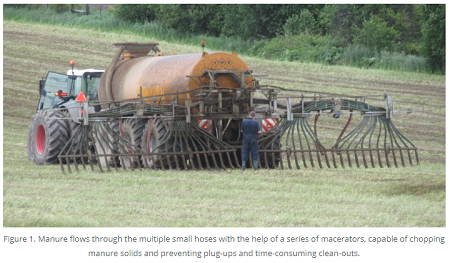In much of Europe there have been restrictions to applying manure only during the growing season. There the technology has been perfected over time to meet those needs. Wouldn’t it be fitting to bring the technology to Ontario without the same application restrictions? I asked a few custom applicators what was holding them back from utilizing the European technology in Ontario. Their response may surprise you.
Application equipment in Europe is being fine-tuned with the potential to monitor phosphorus and nitrogen levels on-the-go and adjust them to meet pre-set requirements. Application booms have been set up to look like sprayer booms with drop hoses spread at intervals similar to sprayer nozzles on 10 inch (25 cm) spacings. They have been designed to allow manure application to occur in several different crop scenarios. This equipment in Ontario would have opportunities from early spring application onto wheat crops; or to forage crops post-harvest; to side-dress application into standing corn and even to edible bean and canola crops before or after planting. Post wheat harvest, application can occur with cover crops, including “laying down” the manure under the crop canopy for red clover stands. Narrow spacing allows greater uniformity and placement where the roots can access the manure more quickly. Manure flows through the multiple small hoses with the help of a series of macerators, capable of chopping manure solids and preventing plug-ups and time-consuming clean-outs.

Increased precision in manure application seems like a logical investment for custom applicators. The increased options for spreading out the manure application season into the summer months would help balance the cost of the technology.
However, according to some applicators, the barrier to advancing this technology into Ontario is the garbage or debris that is in many manure storages. “Everything gets thrown into the pit as if it was a garbage can” according to one applicator. From latex gloves to insemination tubes to cow hoof blocks to fast-food coffee cups and other garbage, etc., these are the items that the macerators can’t consistently chop and ends up plugging the tubes. Custom applicators aren’t willing to update to this type of equipment because it is expensive, and the fear of time and labour associated with plug-ups and clean-outs is just too risky.
Plastics contamination of some municipal waste have been a barrier to using some of these products on farm fields. But sadly, it is also an issue in the manure storages on many farms. So, in this era of one-time use plastics and waste that Canadians are slowly transitioning away from, is it time to train employees, farm staff and visitors doing work in barns to use garbage containers? Containers for plastic and glass waste should be in every barn. Signage reminding everyone not to litter: that the manure storage is the farm’s fertilizer and organic matter source, may help with changing attitudes around waste disposal. Screens around the manure agitation/pump system are an option where removal of contaminants is impossible.
It’s time to use the 3-Rs (Reduce, Re-Use, Re-cycle) to help to advance the 4R’s (Right source, Right time, Right place, Right rate) of manure nutrient stewardship.
Source : Field Crop News